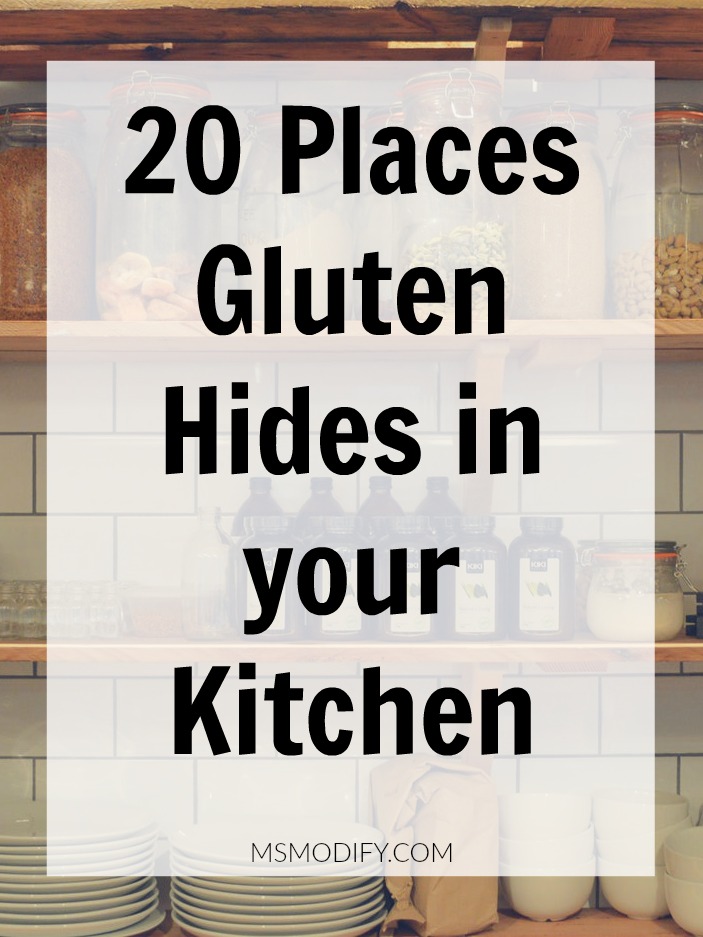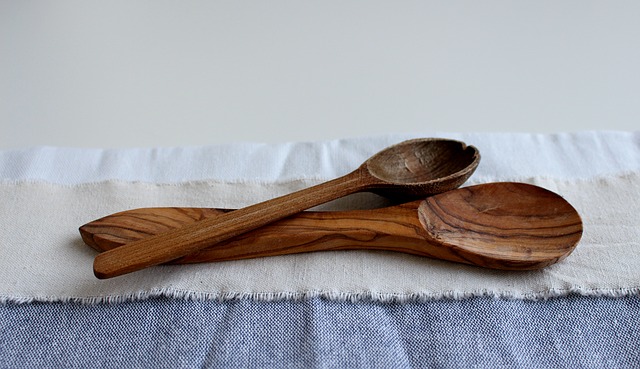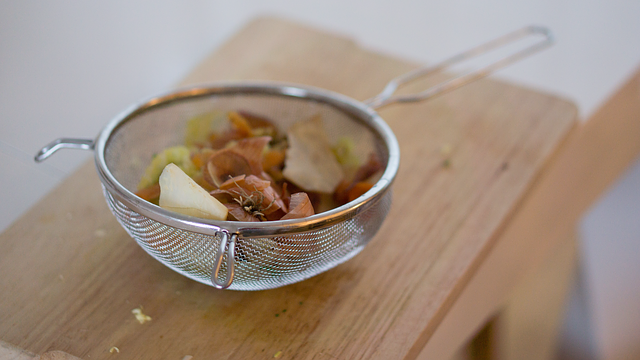How To Clean Gluten Off Surfaces

If you're newly diagnosed with celiac disease, so I'yard sure you're feeling overwhelmed with how much your life is changing! I don't mean to throw a wrench into things, but I believe strongly that knowledge is power… so the sooner you're aware of certain things, the quicker you volition feel better and have command of your health again!
Cross-contamination is something I'm so passionate about (I know I say that often!) because unfortunately no one told me about information technology (yep, not even my doctors or nutritionist) and I learned the hard way.
I went over a year thinking I was working so hard to be gluten free, yet still sick and couldn't figure out why… which was beyond frustrating! As soon as I learned nigh cross-contamination I was able to make big adjustments and regain command of my health (and life)!
When we think of cross-contamination most of united states think about eating at restaurants or at other people's houses… yeah, this is truthful… but let's beginning a lilliputian closer to home… YOUR kitchen!
20 Places Gluten Hides in your Kitchen:
Woods Cutting Boards: The reason for this is considering woods is porous, so no affair how much they've been scrubbed minor amounts of gluten can stay in them.
Butter: Even if you know the butter is gluten free and you're eating gluten free bread, chances are the butter contains staff of life crumbs on it (if at that place is a gluten eater in your house) even if you tin can't run into any.
Toaster: All the breadcrumbs from gluten containing products will get you sick, even if you try to scrub it clean. Make sure you lot have a separate toaster deducted to gluten free items only.
Plastic Utensils and Silicone Spatulas: Gluten can stay in the handle or in modest scratches on the surface, which can't exist removed.
Non-Stick Pans: These items become scratched easily, therefore they harbor gluten. No matter how much you clean them, you run the chance of getting cross-contaminated.

Colander: The petty holes in colanders are difficult to fully clean and can hold traces of gluten. So if you lot've ever used your colander for pasta that wasn't gf, then cross-contamination can occur.
Wooden Spoons: The wooden spoons are porous; therefore gluten can remain inside them.
Oven: If you have a self-cleaning oven, use that. If not, then brand sure you really clean and scrub all surfaces actually well. Don't forget to really scrub the racks and the drawer nether the oven that harbors crumbs.
Microwave: I learned this 1 the difficult manner. I got very sick one time by using the microwave without a lid on my nutrient after gluten was in information technology. If I get to someone's house I bring the chapeau or heat my food with the Tupperware lid on it. In your own kitchen, exist sure to clean your microwave very well, especially the vent within. I recommend using a plate spatter cover when microwaving your food.
Jars of Condiments : Merely like your butter, your condiments virtually likely accept cross-contagion if you have gluten in your kitchen. I highly recommend getting your own dedicated gf condiments and label the jars so everyone knows non to utilize them on gluten-containing items. I besides love squeezable condiments because then you don't have to worry about a knife with bread crumbs going into the jar (just be sure whoever is using it doesn't touch the tip onto their food).

Rolling Pins: If your rolling pivot is made from wood and has ever been used on flour, then it most likely is harboring gluten. Retrieve… anything wood is porous and gluten stays in it!
Non-Stick Blistering Pans: Just like your non-stick pans, I'k sorry to tell you that these probably contain gluten on them if they've ever been used for not-gf baking. Non-stick products scratch easily and gluten sticks to them.
Silicone Baking Pans and Muffin Tins: These are similar to your non-stick baking pans, where gluten can stay in small scratches, which tin't be removed.
Sponges: Lather doesn't remove gluten. If yous clean a dish that has gluten it'southward merely seeping into the sponge and volition contaminate other dishes. If you must share a kitchen that contains gluten, e'er take a separate sponge for washing gluten free dishes.
Sifter: You shouldn't reuse a sifter that'due south been used with gluten-containing flour, even if you launder information technology you won't be able to remove all the gluten molecules from it.

Plastic Bowls and Tupperware: This concept is the same as plastic utensils, gluten can stay in small scratches on the surface, which can't exist removed.
Cast Iron Pans: Fe is porous, then information technology will concur onto gluten as exercise other porous items. If you don't want to get a new pan, I recommend you run it in a cleaning cycle in a self-cleaning oven (information technology gets around 900 degrees fahrenheit) and and then re-season information technology.
Pizza Stone: Since they're porous, they will hold in gluten molecules that you tin can't make clean out.
Airborne Proteins: I unfortunately learned this i the difficult way besides after baking with my grandma using wheat flour (even though I didn't eat it)! Flour tin stay airborne for several afters after utilise (this is also why I avoid bakeries or pizza places that make things from scratch with wheat flour). If y'all inhale the flour, y'all most likely will get ill. For this reason I say don't let anyone broil in your kitchen with wheat flour. If you must, avert the kitchen for several hours and brand sure all surfaces take been thoroughly cleaned.
Tiny Crumbs: You lot can get cantankerous-contaminated by the smallest nibble, then if there is gluten in your kitchen be sure surfaces are ever cleaned and drawers are shut. If a drawer is slightly opened while someone is wiping down the counter, crumbs can fall into and onto utensils (or whatever is in the drawer).
Wow! Now that seems overwhelming… doesn't information technology?! A rule of thumb to recollect is… anything porous or that has been scratched has the opportunity for cross-contamination. I recommend using stainless steel and glass productsin the kitchen as much as possible. I promise it's not as complicated and difficult as it sounds. It'south only hard at offset when you're trying to identify where gluten can be. Once y'all get new items that are strictly for gluten free food, then information technology becomes second nature!
If you're new to a gluten gratis lifestyle and feel overwhelmed or are just realizing you lot may be experiencing cross-contamination, delight don't hesitate to attain out to me for assistance! Annotate below or electronic mail me and I'd be happy to assist yous with your gf journey!
Other posts that relate to this i you may notice helpful:
How to Stock a Gluten Free Kitchen
Gluten & Cross-Contamination
How to Make your Kitchen Gluten Free
*This post contains affiliate links. You lot can read more about that hither .
Source: http://msmodify.com/20-places-gluten-hides-in-your-kitchen/

0 Response to "How To Clean Gluten Off Surfaces"
Post a Comment